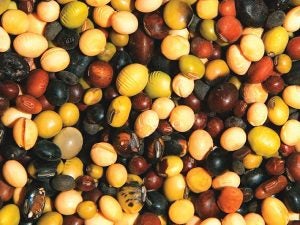With roughly 7 percent of children and 2 percent of adults in the U.S. having some kind of food allergy, the related health care costs a whopping $25 billion annually. Severe reactions are common, and death is possible in the most serious instances. Plus, patients miss out on school or work.
So there is a major food-industry push to find ways to reduce the suffering caused by food allergies. Processing companies already spend a lot of effort to label products so people can avoid items they’re allergic to. But what if we could do better? What if we could enjoy the foods we like without worrying they might trigger a health crisis? Enter genetic engineering and other plant breeding methods.
Eliot Herman has spent his career studying why plants trigger allergic reactions and how to reduce the chance of them being triggered. Herman is a member of the Crop Science Society of America and recently presented his work at the virtual 2020 ASA-CSSA-SSSA Annual Meeting.
“Food allergies are an important societal issue. By altering food and by treating sensitive individuals, this can be mitigated, improving their lives and impacting the total medical expenditure in the U.S.,” says Herman.

Herman focuses particularly on soybeans. Soybean allergies especially affect children and infants. And because soybean products like oil and protein are used in countless food products, it’s hard to avoid.
Earlier in his career, Herman found the protein made by soybeans that is responsible for most soybean allergies. Now, he has dedicated his work to understanding why this protein is so aggravating and how we can reduce it in the crop.
To do so, he’s turning to animal models. Pigs sometimes have a soybean allergy very similar to that of humans. Herman worked with a research team that bred pigs that are extra sensitive to soybeans. Testing new crops on allergic children wouldn’t be possible. But these pigs can be used to see how well plant breeders have done at removing allergenic proteins from soybean seeds.
That’s a feat that Herman has done not once, but twice. Previously, Herman partnered with the company DuPont to produce a line of soybeans that couldn’t make the most allergenic protein.
They made this soybean line using genetic engineering. There was also interest in a non-GMO soybean without the allergenic protein, created with more traditional breeding methods.
So Herman went back to the drawing board. He worked with his colleagues to find a line from the U.S. Department of Agriculture’s national soybean collection that naturally didn’t make the allergenic protein. They then crossed that line of soybeans with a more commonly grown soybeans to create a new, productive soybean with reduced allergic sensitivity.
“This new soybean is intended to be a low-allergen prototype to be tested as a conventional, non-GMO line to mitigate the allergic response for consumers,” says Herman.
The hypersensitive pigs can now be used to test if these low-allergen soybeans are safe enough for allergic individuals. That wouldn’t only be good for allergic people who want to safely eat more items from the grocery store. It would also be good news for animals.
Since pigs are often fed soybeans, a low-allergen soybean could reduce their own allergic response. Dogs also have a high prevalence of allergic reactions to soybean, which is used in some dog foods. So reducing the crop’s allergenicity would be good for man’s best friend, too.


